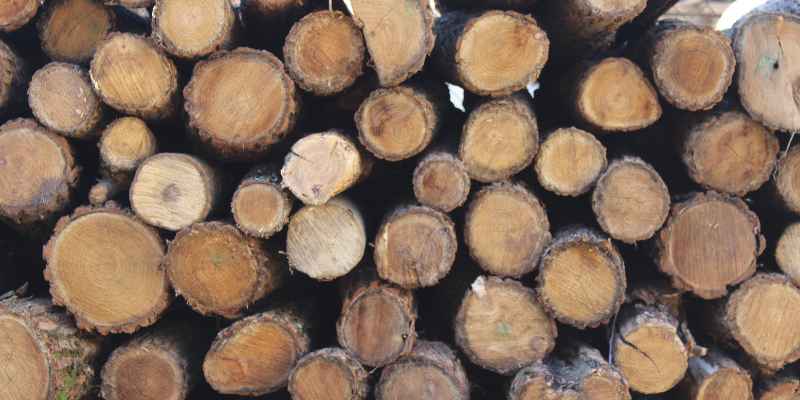Wood expands in heat and contracts in cold temperatures. The expansion and contraction occur due to changes in moisture content and the thermal properties of wood.
When exposed to heat, wood absorbs moisture from the air, causing it to expand. Conversely, in colder temperatures, the moisture content decreases, causing the wood to contract. This natural process can lead to warping, cracking, or splitting of wooden objects or structures.
Therefore, understanding how wood reacts to temperature changes is essential in woodworking and construction projects to ensure proper planning and maintenance.

Understanding Wood Properties
Understanding wood properties is crucial for DIY enthusiasts. It’s worth noting that wood tends to expand in heat and contract in cold temperatures, affecting its dimensions and overall stability. By comprehending this behavior, one can make informed decisions when working with wood for various projects.
Structure of Wood
The structure of wood plays a crucial role in determining its properties and behavior in different environmental conditions. Wood is composed of elongated cells called fibers, which are bound together by a matrix substance known as lignin. This unique composition gives wood its strength, flexibility, and ability to expand or contract in response to changes in temperature and humidity.
Properties of Wood
Wood has several inherent properties that contribute to its overall characteristics. First and foremost is its ability to expand and contract. This property is mainly influenced by the moisture content within the wood. When exposed to heat or high humidity, wood fibers absorb moisture and expand, causing the wood to swell. Conversely, in cold or dry conditions, the moisture within the wood decreases, resulting in contraction and shrinkage.
Another essential property of wood is its thermal conductivity. Wood is a poor conductor of heat, which means it retains heat well. This property allows it to maintain a relatively stable temperature, making it suitable for insulation purposes.
Furthermore, wood has excellent durability and strength, making it a preferred choice for construction and furniture. It offers a natural beauty with its unique grain patterns and textures, adding an aesthetic appeal to any space. Additionally, wood is also biodegradable and renewable, making it an environmentally friendly choice.
To further understand how wood behaves in different temperatures, it is essential to examine its specific heat capacity. Specific heat capacity refers to the amount of heat energy required to raise the temperature of a given mass of material by a certain amount. Wood has a relatively low specific heat capacity, meaning it heats up quickly but also cools down rapidly.
To summarize, wood is a versatile material with unique properties that allow it to expand or contract in response to changes in temperature and humidity. Its structure, consisting of fibers held together by lignin, contributes to its overall strength and flexibility. Wood’s inherent properties, such as its ability to retain heat and its durability, make it a valuable resource for various purposes.
Table: Physical Properties of Wood
Property | Description
Expansion and Contraction | Wood expands and contracts with changes in temperature and humidity.
Thermal Conductivity | Wood is a poor conductor of heat, making it suitable for insulation purposes.
Durability | Wood is known for its strength and longevity in construction and furniture.
Aesthetic Appeal | Wood’s unique grain patterns and textures add natural beauty to any space.
Biodegradability | Wood is a renewable and environmentally friendly material.
Specific Heat Capacity | Wood has a relatively low specific heat capacity, quickly heating up and cooling down.
Remember, understanding the properties of wood is essential when considering its suitability for various applications and its behavior in different temperatures. Whether it’s for construction, furniture, or insulation purposes, the distinctive characteristics of wood make it a remarkable material to work with.
Thermal Expansion Of Wood
Wood, nature’s versatile material, is known for its strength, durability, and adaptability. However, have you ever wondered how it responds to different temperatures? In the world of construction and woodworking, understanding the thermal expansion of wood is crucial. During temperature changes, wood experiences expansion or contraction, which can affect its dimensions, structural integrity, and overall performance. Let’s delve deeper into the fascinating world of wood and explore how it expands in cold and hot environments.
Expansion In Cold Environments
When exposed to cold temperatures, wood contracts. This phenomenon occurs because the molecules in the wood slow down, reducing their energy and causing the material to shrink. Wood has a low coefficient of thermal expansion, meaning it contracts less compared to other materials, such as metals. However, it’s important to note that different wood species may exhibit varying degrees of contraction. For example, certain hardwoods, like oak, might contract less than softwoods, such as pine.
Expansion In Hot Environments
On the other end of the temperature spectrum, when subjected to heat, wood undergoes expansion. As temperatures rise, the molecules within the wood gain energy, leading to an increase in their movement. This increased movement causes the wood to expand in all directions. Similar to cold temperatures, different wood species may have varying expansion rates. Hardwoods generally expand less than softwoods, but the specific type and cut of wood will also play a role in determining the degree of expansion.
Factors Affecting Wood Expansion
Wood expansion is influenced by a variety of factors, including temperature changes. In colder temperatures, wood contracts, while in higher temperatures, it expands. Understanding these factors can help in preventing damage and preserving the integrity of wooden structures.
Wood is a natural material that can expand and contract based on its environment. Understanding the factors that influence wood expansion is crucial for anyone working with wood. In this section, we will explore two primary factors that contribute to wood expansion: moisture content and the species of wood.
Moisture Content
One of the most significant factors impacting wood expansion is its moisture content. Wood is hygroscopic, meaning it has the ability to absorb or release moisture from its surroundings. As moisture is absorbed, wood expands, and as it dries out, it contracts. This expansion and contraction can occur due to changes in relative humidity, exposure to water, or even variations in temperature.
Moisture content directly affects wood expansion, and considering it is critical for any woodworking project.
The moisture content in wood can be classified into two categories: equilibrium moisture content (EMC) and fiber saturation point (FSP). EMC refers to the moisture content at which the wood is in equilibrium with its surrounding environment. On the other hand, FSP is the point at which wood fibers are saturated with water. Both EMC and FSP are vital in determining the potential expansion or contraction of wood when exposed to different moisture conditions.
It’s important to note that different wood species have varying moisture content characteristics, which affects their expansion behavior.
Species Of Wood
The species of wood plays a significant role in its expansion and contraction behavior. Different wood species have distinct cell structures and moisture content characteristics, resulting in varying expansion rates. For example, softwoods tend to have higher expansion and contraction rates compared to hardwoods due to their lower density and higher moisture content.
By considering the species of wood you are working with, you can anticipate and plan for its expansion and contraction.
Some wood species, such as teak and cedar, have natural resistance to moisture and are less prone to expansion and contraction. Others, like oak or pine, are more susceptible to changes in moisture content. It’s crucial to select the appropriate wood species for your project, taking into account the environment in which the wood will be used.
In conclusion, moisture content and wood species are key factors influencing wood expansion. Understanding these factors will help you make informed decisions when working with wood, ensuring the durability and stability of your projects.

Implications And Practical Applications
Wood expands and contracts due to changes in temperature. Understanding this phenomenon is crucial for practical applications such as construction and furniture making, as it helps in determining appropriate dimensions and tolerances for wood products in different climate conditions.
Understanding whether wood expands in cold or heat is crucial in various industries, especially in furniture and construction. The implications of this knowledge can greatly impact the design, durability, and longevity of wooden objects. By considering the effects on furniture and construction as well as implementing preventative measures, we can ensure the proper use and maintenance of wood in different environments.
Effects On Furniture And Construction
In the realm of furniture, the expansion and contraction of wood due to temperature changes can lead to several issues. For instance, if wood swells in high heat or humidity, it can result in tight-fitting drawers, doors, or joints. This can make furniture difficult to open or close smoothly. On the other hand, in cold temperatures, wood may shrink, causing gaps or cracks in wooden furniture pieces. These fluctuations in size can not only affect the functionality but also impact the overall appearance and stability of the furniture.
Similarly, in the construction industry, the expansion and contraction of wood play a significant role. Wooden structures such as doors, windows, and frames can become problematic if not accounted for. In extreme heat, wood may expand, leading to warping or bowing, affecting the structural integrity. In cold weather, the contraction of wood can cause joints to loosen, potentially compromising the stability and safety of the structure.
Preventative Measures
To mitigate the potential issues arising from the expansion and contraction of wood, several preventative measures can be taken. One common approach is to implement proper seasoning or drying techniques in the initial stages of wood preparation. This helps to minimize the moisture content and reduce the likelihood of significant size changes with temperature fluctuations.
Another preventive measure is to treat the wood with appropriate coatings or finishes. These provide a protective layer that reduces the direct impact of temperature changes on the wood, thus minimizing expansion or contraction. Furthermore, proper installation techniques that allow for slight movement of the wood without compromising the overall structure are essential.
Regular maintenance is also essential to prevent potential problems caused by temperature-related size changes. This includes regular inspection, repair, and reapplication of coatings or finishes as necessary, ensuring the wood remains protected.
By understanding the implications of wood expansion and contraction and implementing preventative measures, we can enhance the durability and longevity of wooden furniture and structures. This knowledge allows us to make informed decisions during the design, construction, and maintenance processes, ensuring the wood remains strong, stable, and visually appealing in different environmental conditions.
Conclusion
Understanding how wood expands in cold or heat is crucial for its usage and maintenance. While wood contracts in cold temperatures and expands in heat, knowing the extent to which it expands or contracts can help prevent structural damage and ensure its longevity.
By taking proper precautions and implementing appropriate measures, wood can withstand various temperature fluctuations, resulting in a durable and stable material for construction and furniture.


